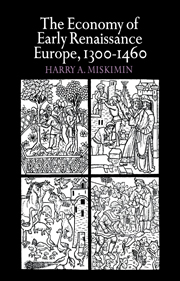4 - THE INTERNATIONAL ECONOMY
Published online by Cambridge University Press: 29 January 2010
Summary
ORIGINS
Even during the most dismal and bleak centuries of the Middle Ages, long-distance trade was undertaken by those intrepid adventurers who were prepared to risk the dangers of sea or overland travel in search of the great rewards afar, which were kept at high levels by the very dangers that turned away the fainthearted. By the beginning of the thirteenth century, however, trade had become more a way of life than uncertain adventure, and regular institutions and trade routes had been devised by medieval merchants for their convenience and profit. As Europe emerged from the troubled centuries that followed the collapse of Charlemagne's empire, a few regions at first slowly found peace, or at least some degree of political security, and then in time, whole countries came to experience the benefits of an increasingly stable political order. With greater security came greater opportunities for trade. Thus, the early unification of Flanders under relatively strong Counts allowed increased exchange and production of goods. To the south, the expansion of European political power in the Mediterranean with the clearing of the Arabs and, ultimately with the Crusades, into the Levantine coast itself, served to rekindle the embers of the active trade conducted in antiquity, which even the Arabs' partial domination of the Mediterranean was impotent to extinguish totally. In central France, the Counts of Champagne had discovered the profitability of encouraging merchants and thus expanding their own sources of revenue. Consequently, the French counts sought to extend their own political influence by bargaining with other feudatories so as to secure safe-conducts for merchants attending the supervised fairs sponsored by the Counts in the Champagne district.
- Type
- Chapter
- Information
- The Economy of Early Renaissance Europe, 1300–1460 , pp. 116 - 163Publisher: Cambridge University PressPrint publication year: 1975



